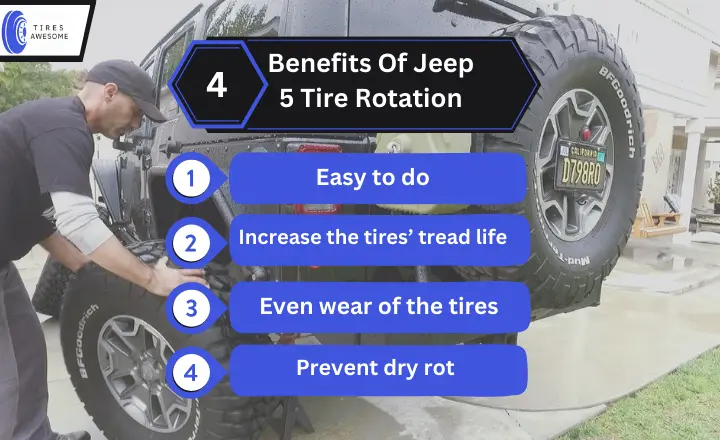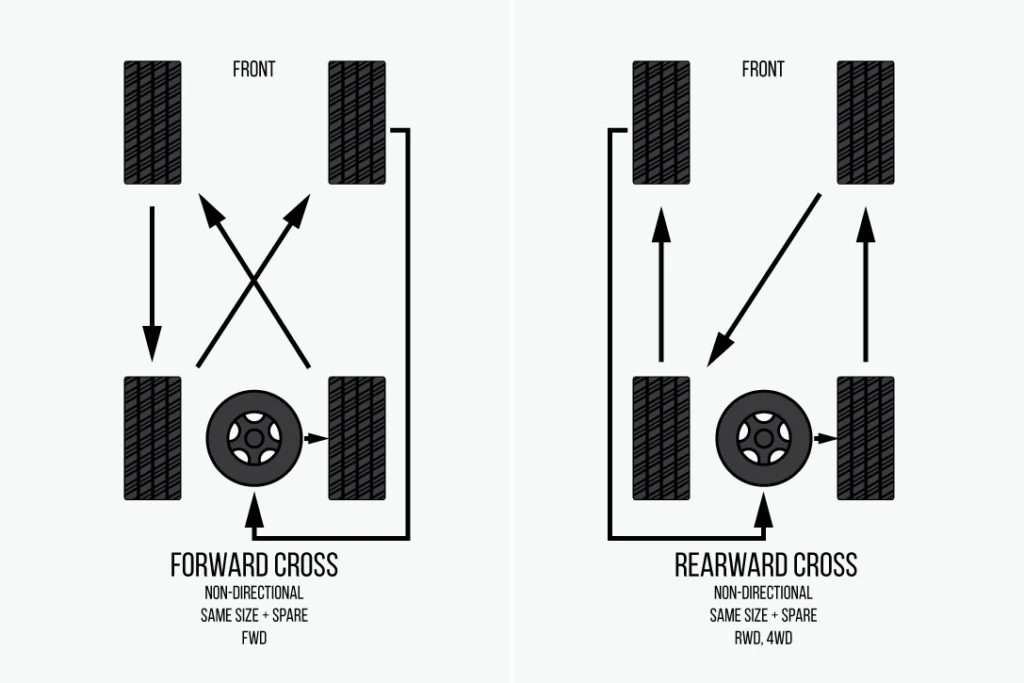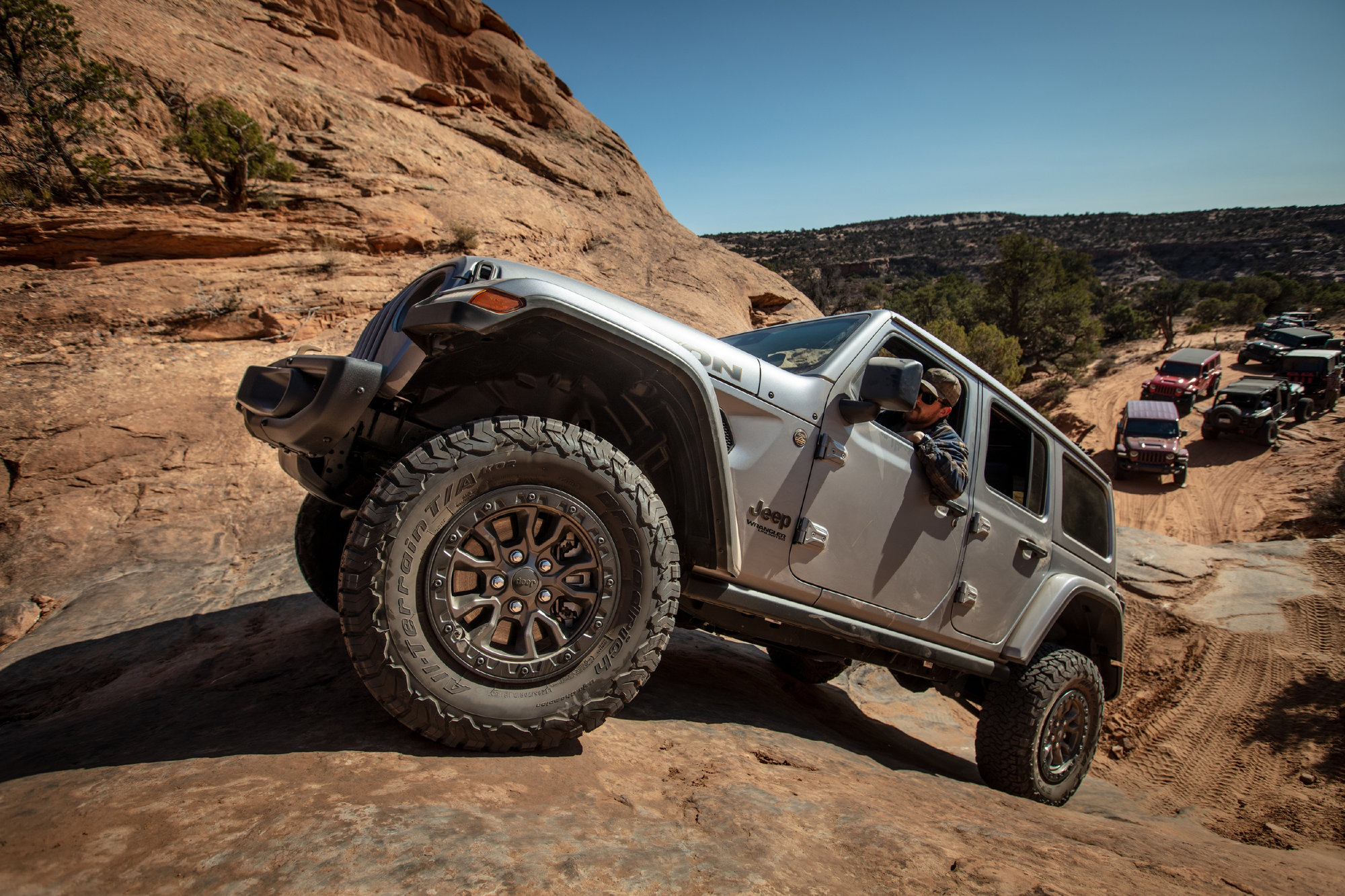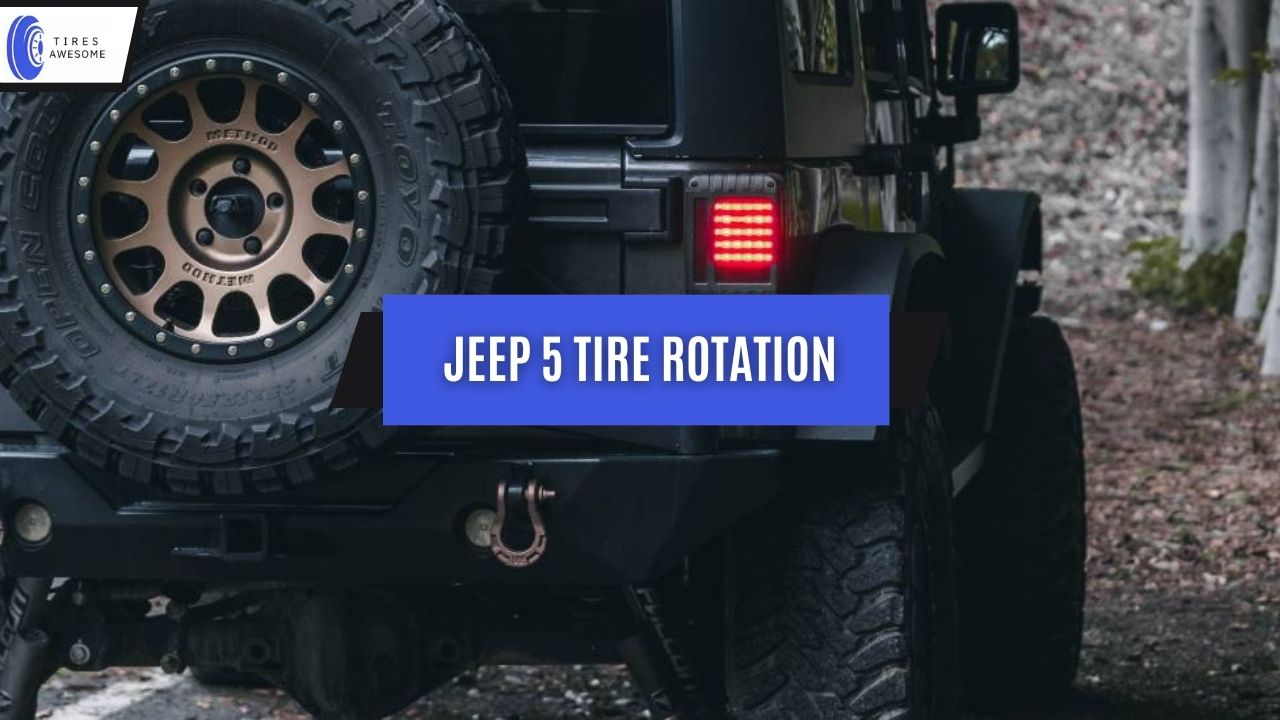The Jeep 5 Tire Rotation uses a unique way to make sure your tires wear out evenly. This keeps the tire grooves at the same depth for the best performance. This guide helps you save money and make your tires last longer, giving you a smooth and safe drive for many years. So, improve your Jeep’s performance and grip on all surfaces.
Should you do a 5 tire rotation?
Well, it can be a good idea in certain situations. A 5 tire jeep rotation involves rotating all five tires on your vehicle instead of just the typical four. This includes moving the spare tire into the rotation cycle.
A 5-tire rotation can be beneficial if you have a full-size spare and want to evenly distribute wear across all five tires. This can help extend the life of your tires and improve overall traction and handling. It’s particularly helpful for all-wheel drive vehicles, where having consistent tread depth is essential for proper functioning.
Is a Jeep 5 tire rotation worth it? [Benefits]
Yes, It is indeed worth it. By rotating all five tires regularly, you can extend their lifespan and increase their mileage potential. Discover the benefits of this tire rotation below:

Easy To Do
It is an easy process and eliminates the need to put your entire Jeep on jack stands, unlike the 4-tire rotation. A spare tire simplifies things; you only need a stock jack and nut wrench. The convenience of swapping tires cannot be overstated.
Increase The Tires’ Tread Life
By rotating your tires in this manner, you can significantly increase their longevity by up to 20%. If your Jeep’s tires are expected to last around 35,000 miles, performing a 5-tire rotation can add up to 7,000 miles to their lifespan. Instead of replacing worn-out tires at 35,000 miles, you could reach an average of 42,000 miles before needing new ones.
Even Wear Of The Tires
Even tire wear helps save fuel by lessening resistance and making the tires roll easier. When all tires have the same tread depth, they grip the road better, making driving safer and more efficient in different conditions. Each tire will be used equally in the front, back, left, and correct positions. This way, all tires wear out evenly.
Prevent Dry Rot
The five-tire rotation ensures longevity and optimal functioning, particularly in hot climates where tire rubber degrades rapidly. With the spare tire in the process, you can prevent dry rot that may occur when left unused for an extended period. This 5 tire jeep rotation pattern ensures that each tire bears an equal amount of wear and tear, promoting even tread wear and extending the overall lifespan of the tires.
Jeep 5 Tire Rotation Diagram
In the diagram provided below, the primary objective of these Jeep 5 tire rotation patterns is to promote even wear among all five tires on your vehicle. The decision between styles showcased in the diagram ultimately comes down to personal preference.

Mixing two methods will result in the tires returning to their initial positions, rendering your routine useless. You have decided on five tire rotation patterns that work for you; printing them out and storing them in your Jeep is a good idea.
How Do You Rotate 5 Tires On A Jeep?
Discover the comprehensive instructions in this segment, which provide a clear and concise guide on executing a 5 Wheel Rotation Jeep.
Method 1
Step 1: Remove the spare tire and replace it with the front passenger tire. Now, you have a spot to relocate one of the other tires.
Step 2: Mount the front passenger tire on the rear passenger side.
Step 3: Remove the rear passenger tire and install it as the new front drive.
Step 4: Perform a rotation by swapping the front and rear drive tires.
Step 5: Return the rear drive tire as a spare to the back of your Jeep.
Method 2
Step 1: Remove the spare tire from its storage location. It is typically mounted on the back of the vehicle. Replace it with the rear passenger tire.
Step 2: Now, take the rear passenger tire and exchange it with the front passenger tire.
Step 3: Use the front passenger tire and fit it into the rear drive tire position. You’ll ensure that all four wheels receive equal wear over time.
Step 4: Rotate the original rear drive tire to replace the front drive tire. It helps to maintain consistent tread across all four wheels.
Step 5: Move the front drive tire to where the spare tire was initially located. Every wheel has been involved in the rotation process while giving you easy access to your spare if needed.
How Often Should You Do A 5 Tire Rotation Jeep?
Top tire makers recommend rotating your tires twice yearly or every 5,000 to 7,500 miles, whichever comes first. Check your tire or car manual for specific guidance on tire rotation frequency. You’ll need a few tools: a jack, a lug wrench, and a jack stand for extra support. The kind of Jeep you have, how you drive, and the type of roads you use all help decide how often to rotate your tires.
When Is Too Late For Jeep Tire Rotation?
It is essential to regularly measure the tire tread depth of all five tires. A minimum difference of 3/32 in tread depth between tires is necessary for proper rotation. Uneven tire wear can lead to unequal wheels, causing unnecessary strain on the drivetrain. This stress can significantly damage essential components such as the axles, rare differential, or transmission.
How Much Is A Jeep Wrangler Tire Rotation?

The cost can change depending on where you live or the rates of the auto repair shop. On average, tire rotation of a Jeep Wrangler costs between $24 and $120. If you also get an alignment check for tires, it could cost more. Regular jeep wrangler 5 tire rotation helps it perform better and makes your tires last longer. Delaying expensive tire replacements can save you money in the long run.
What Is The Recommended Tire Rotation Pattern For A Jeep?
The recommended tire rotation pattern for a Jeep depends on whether it’s a two-wheel drive or a four-wheel drive model.
Two-wheel drive Jeeps: For 2-wheel drive Jeeps, it’s typically recommended to perform a front-to-back tire rotation, moving the rear tires to the front and the front tires to the rear. This helps to ensure even wear across all four tires and can extend their lifespan.
Four-wheel drive Jeeps: For 4-wheel drive Jeeps, the tire rotation pattern may differ slightly. In addition to performing the front-to-back rotation, it’s also important to swap left and right sides. This means that the front left tire moves to the back right position, and vice versa, while also similarly switching the rear tires.
Conclusion
A Jeep 5 tire rotation is a recommended maintenance practice with several benefits. It helps them last longer and makes your car handle better. It also improves your gas mileage and boosts your car’s performance. To keep your vehicle running well, follow the maker’s advice on when to rotate your tires. You can do this yourself or get a reliable mechanic to do it. Regular maintenance, like tire rotation, is a great way to care for your Jeep.
Related Question
Can I Swap Front And Rear Tires?
You can switch your front and rear tires. Tire rotation helps all tires wear out at the same rate, making them last longer and allowing your car to run better. Usually, you should rotate your tires every 5,000 to 7,500 miles.
How Long Does It Take To Rotate All Four Tires?
A tire rotation lasts around 15 minutes. The process may extend to approximately one hour if additional services are included. The technician will rearrange the tires according to your vehicle.
What Is The Difference Between Tire Alignment And Tire Rotation?
Tire rotation and wheel alignment serve distinct purposes. Rotation redistributes tire wear, while alignment maintains proper tire angles. Both services are vital for prolonging tire life and ensuring efficient vehicle operation.
How Often Should You Rotate Tires On A Jeep 5?
For a Jeep 5, it’s generally recommended to rotate the tires every 6,000-8,000 miles. This helps ensure even wear and tear on all four tires, which can extend their lifespan and improve overall performance.
Is It Ok To Skip A Tire Rotation?
It’s generally not a good idea to skip tire rotations if you want to maximize the lifespan of your tires. Tire rotations help to ensure that your tires wear evenly, which can extend their lifespan and improve your vehicle’s performance. While it might be tempting to skip a rotation when you’re short on time or money, it’s generally best to stick to the recommended schedule.

